
views
Evaluating Your Dog
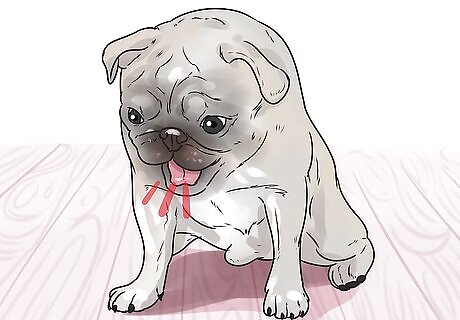
Check to see if your dog is coughing. Initially, if your dog is capable of coughing, wait a few moments to see if your dog can manage to cough up the obstruction on their own. Only wait for this possibility if your dog seems to be able to breathe well. If your dog is wheezing, struggling, or gasping for air, call a vet immediately. Call a vet if your dog is in immediate danger. Many vets provide an after-hours emergency hotline that you can call for help. Be prepared. Create a list of emergency vet numbers and keep it somewhere safe in case of an emergency. This way you won't have to go searching online for a number. Alternatively, add an emergency vet number to your phone contacts, or, if your vet supplies it, pick up a fridge magnet with contact details on it.
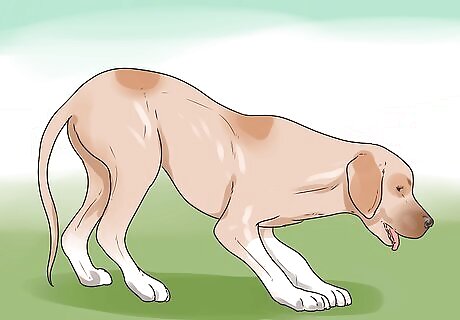
Check for signs of choking. Dogs may show several telling behaviors if they aren’t able to breathe. When trying to determine if your dog is choking, begin by first attempting to calm them — the more panicked the dog becomes, the greater their demand for oxygen and the worse the situation. Signs that a dog is choking include: Gagging or drooling excessively — this is one of the most obvious ways to tell if your dog is choking. If they are drooling heavily and unable to swallow, choking is more likely. Unable to swallow Standing in the “air hunger position” with their head and neck held low and in a straight line Acting unusually agitated or frantic, pawing at their mouth, and whimpering Coughing forcefully, wheezing, or gasping for breath Having grey or blue gums Having a visible object in the back of their throat Displaying exaggerated chest movements Collapsing Losing consciousness

Encourage your dog to swallow. This is a useful strategy to help you determine if your dog is truly choking. You can do so by offering your dog a treat, gently rubbing their throat, or by pinching their nostrils together. If your dog eats a treat, then they are not choking. Once the dog swallows, if the sound stops, they aren't choking.

Look inside the dog’s mouth. By visually checking the dog’s mouth, you can find out if an object is obstructing its airway and act accordingly. Gently open its mouth by squeezing its upper lip inwards over the big molars at the back of the mouth. At the same time, apply downward pressure on the point of its jaw to further open the mouth. Look as far back towards its throat as possible — it helps to have a flashlight and someone else to hold the dog for this. You are looking for any obstructions such as a piece of bone or a stick. Restrain a larger dog before opening its mouth wide. Do this by grabbing the scruff of hair between the ears and holding the dog's head steady. If you can see something in the throat, try to grip it with pliers and remove it. Take extreme care not to accidentally force the object further back.

Call the vet. If your dog is choking, showing signs of choking, or indeed having breathing difficulties, always phone your vet for advice. The exception to this rule is if your dog has completely collapsed or has lost consciousness. In that instance, begin administering what first-aid you can. You may be talked through first aid procedures while waiting for emergency help and likely you will be asked to bring your pet in immediately. If you cannot reach your vet, look for emergency 24-hour veterinarians. Their number will usually be in the phone book, or you can call a local animal welfare or rescue agency for details. Emergency vets or animal hospitals are usually available in major towns and cities. If you're in the US, your local emergency number will be able to give you the ASPCA or the Humane Society emergency number. They will have an emergency vet to give you help on the phone.
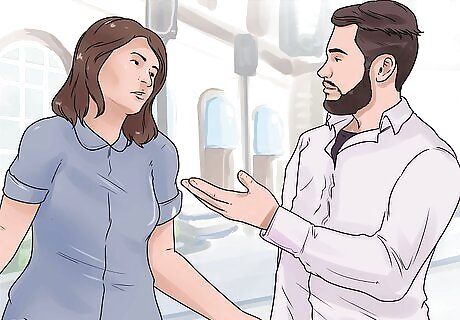
Seek out someone else to help. Whether you take your dog to the vet or try to administer first-aid, it’s best to have another person present to help you. If you need to drive your pet to an emergency vet, it is best to have one person with the dog to help immediately if the situation worsens. If the vet has you try to dislodge the object yourself, it’s advisable to do so with someone else's help.

Rule out other causes. Because you can do more harm than good by executing certain maneuvers on a dog that doesn't need them, it is important to be as certain as possible that the dog is actually choking and in danger, rather than merely appearing to choke. The following are conditions that may cause a dog to behave similarly to a dog that’s choking. A Long Soft Palate: A common anatomical quirk found in many dogs is having a tongue and a soft palate that are too big for their mouth. This is especially common in brachycephalic dogs (those with shortened noses and baby-like faces) such as the Pug, Pekingese, Lhasa Apso, and Shih Tzu, though it also occurs in small breeds such as the Poodle, West Highland White Terrier, Dachshund, Spitz, and Pomeranian. The result is that when the dog breathes in sharply, it physically sucks the end of the soft palate into the entrance of the windpipe. This temporarily narrows or blocks the windpipe, and the dog makes a series of dramatic snorting or gasping sounds, as if choking. This is only a temporary crisis because when the dog swallows, the soft palate flips away from the windpipe and the dog can breathe again. If you’re unsure, give the dog food or a treat. If it takes and swallows the food, it isn’t choking. Kennel Cough: Kennel cough is an infection that causes the airway to become sore, inflamed, and irritable. Even the simple act of breathing in cool air can tickle the throat and trigger coughing episodes. This cough can be dramatic and is commonly mistaken for the dog having something stuck in its throat. Again, check to see if the dog is able to swallow by offering it something to eat. If it can swallow, it is extremely unlikely the dog is choking. Do, however, contact your vet to see if he or she would recommend an examination for the kennel cough. Heart Disease: An enlarged heart pressing on the airways or a heart in failure can sometimes mimic choking. The dog may breathe in a distressed manner, cough, and may even have blue-tinged gums. This condition is harder to differentiate from choking, but in general the signs are slow to develop, with the dog becoming less energetic and more lethargic for a day or two beforehand. Choking, on the other hand, is far more common in active, inquisitive dogs and comes on suddenly.
Dislodging The Object
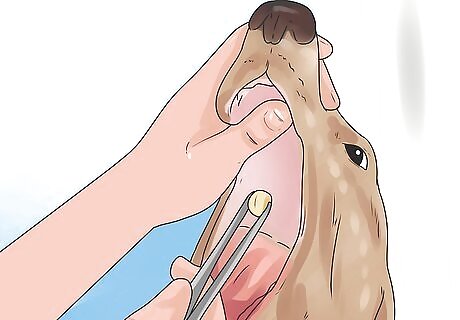
Grasp the obstruction with pliers or tweezers. If you are able to see the object blocking the airway and the vet advises you to do so, attempt to remove the obstruction gently. Only attempt to remove the obstruction if you can clearly see and grasp it and your dog is not frantic. You risk lodging the object in even deeper if you accidentally push it without being able to see it. If the dog is frantic, you risk being bitten badly. Go immediately to an emergency vet or animal hospital instead.
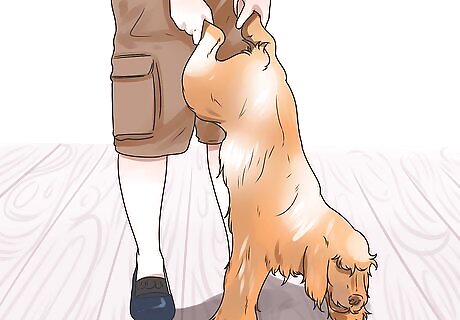
Help your dog to dislodge the obstruction. Gravity can help your dog dislodge an obstruction. To help, you will have to hold the dog upside down and try to shake the object loose. Pick up a small or medium dog by its hind legs. Hold the dog upside down and try to shake the object out of its mouth with the benefit of gravity. You won't be able to hold a larger dog upside down, so instead keep the front paws on the ground and lift up its hind legs (in the same manner as holding a wheelbarrow) and tilt the dog forward.
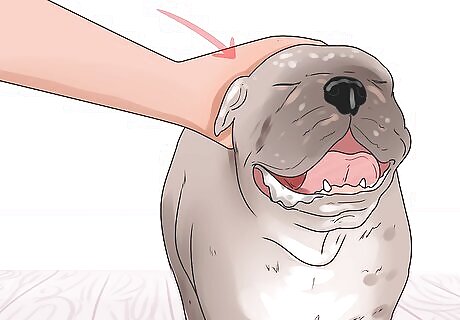
Use back blows. If you can't help your dog dislodge the object by tilting your dog forward, you can forcefully strike its back to help dislodge the choking hazard. Using the heel of your hand, deliver 4-5 sharp blows on the dog between the shoulder blades. Take care not to use excessive force with small dogs, as there is a risk of fracturing ribs, which itself can be life-threatening if a broken rib punctures a lung. If this does not work initially, try once more.

Consider performing the Heimlich maneuver. Because you can easily injure your dog using this maneuver, use it ONLY when all other options have been exhausted. Only start the Heimlich maneuver if you can be sure your dog is choking on an object. Place your arm around the dog's waist. Ensure that your dog's head points down, as gravity will help the object dislodge as you perform the procedure. Make sure your hold on the dog is firm, but not too tight. It is a good idea to have someone help you scruff the dog while you do this. It will help keep the dog steady and can restrain a frantic animal. Form a fist and bring your other hand around and cover your fist with it. Your two-handed fist should be placed on the soft spot just under the ribcage. The size of the dog will affect the exact positioning of your hands. If you have a small- to medium-sized dog, you will want to use 2 fingers rather than a fist (still using the same amount of force) so you do not damage your dog's ribcage. Quickly and firmly give 3-5 thrusts inwards and upwards. Repeat in sets of 3-5 thrusts up to 3-4 times. Take care not to use excessive force as you could crack ribs or rupture the spleen.
Dealing with the Aftermath
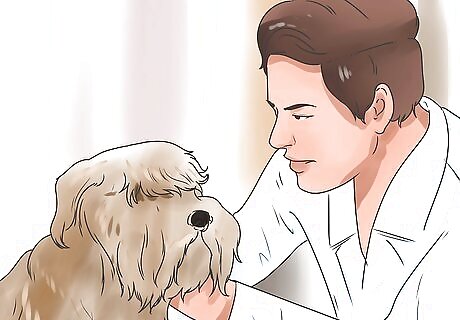
Check to see that your dog is breathing normally once you've removed the object. If not, then start artificial respiration on it immediately. If your dog has no pulse, commence CPR (cardio-pulmonary resuscitation) on your dog. If your dog needs resuscitative measures, do what you can immediately and have someone else call the vet to get further instructions.
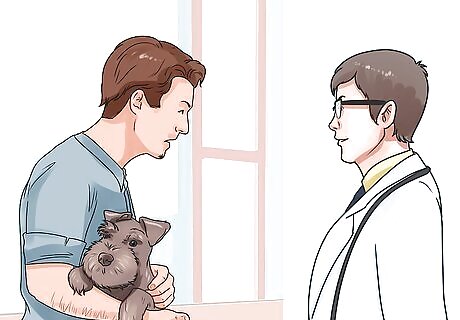
Take your dog to the vet. Even if you manage to dislodge an object, it is a good idea to get your pet to the vet to be checked for any further problems or injuries. Keep your pet calm and get your dog to the vet as quickly and as safely as possible. Pay close attention to your dog to make sure it is able to maintain normal breathing.

















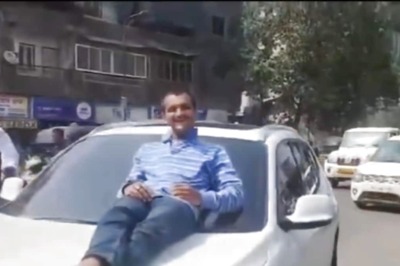


Comments
0 comment